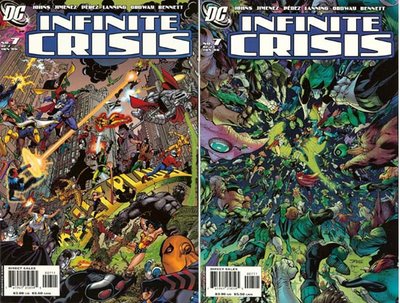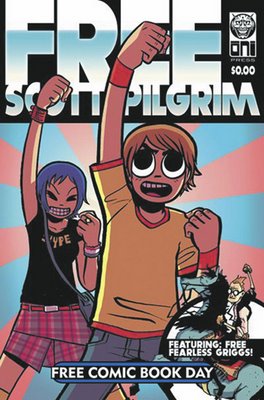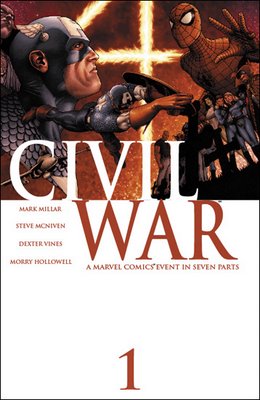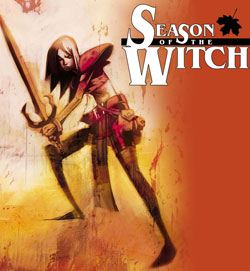Infinite Crisis #7 Review

I realize that this sounds terribly, terribly patronizing, and I apologize for that, but what can I say, it is what I believe, and if my belief is patronizing...well, I'm sorry. Okay, here goes - I think that most people who think Infinite Crisis #7 was a good comic are, well, deluding themselves.
This is different from people who liked Infinite Crisis as a whole.
This is also different from people who "didn't think it was THAT bad" or anything like that.
That's fine by me.
But "it was good"?
Come on now.
This was not a good comic book. And I personally don't even really blame Geoff Johns. This read like one of the most rushed, thrown together comics I can recall reading.
So if you think it was a GOOD comic (and not "I thought this was going to suck, but it didn't" or anything like that), I can't help but question your skills of perception.
Why I don't blame Johns is because so much of Infinite Crisis, as I've written in the past, has been just achieving various purposes. Making Batman less dickish. Making the DC Universe a little brighter. Addressing some continuity things that apparently are driving, like, five people nuts. Stuff like that.
Infinite Crisis was never about telling a story, but at least in the first six issues, there was a bit of an attempt.
That attempt ceased to exist in #7. #7 was just a collection of "big" scenes. To the point where the greatest superhero/supervillain fight ever is awarded something like, five pages of story. And two of them certainly APPEAR as though they were not even inked in time, so they were just colored red. What do you folks think? Do you think DC actually did that? Just colored a bunch of a two-page spread to save some time? Or was it just a stylistic choice? And the other scenes were drawn so half-heartedly that I can easily claim that certain characters DIDN'T die, mainly because they were drawn so poorly I could argue they were some other character. In addition, how odd is the idea of having a bunch of characters show up who almost no one this side of, well, me know just for the sake of having them slaughtered?
Later on, there's a major scene with Batman and Wonder Woman. The pacing of the story totally strips the scene of any merit, and the art hurts it as well. To wit, a sound effect makes it sound like Batman tried to shoot Alex Luthor, when actually, he clearly was just cocking the gun. Later, Wonder Woman throws her sword to the ground, breaking it. The art doesn't show that, though, choosing instead to just show her dropping the sword and it breaking for some unexplained reason. Wonder Woman also completely reverses her well-though-out position on the killing issue - and we are given no explanation WHY.
That is what Infinite Crisis is about, though. It is about getting Wonder Woman to say, "Hey, killing is wrong." WHY she says it is unimportant, I guess.
Another point in this series is about how the big three are not needed, because we have so many second-tier characters. This is demonstrated in a two-page spread by Joe Bennett where he apparently was given a lunch break to pencil and ink a two-page spread with 50-odd characters on it. At least that's what the art looks like (as an aside, are these the only superheroes not slaughtered by Superboy?). However, early on in the issue, we saw that, if it weren't for the big-name heroes, the lesser-known heroes would have been slaughtered by the bad guys. So...huh?
Also, Donna Troy...what the heck? They didn't even really ATTEMPT to tie her in, did they? Man, she looks like a total moron in this series. Yes, it could be explained somewhere else, but the fact remains that it SHOULD have been explained HERE, and it wasn't. That is not good.
So, what do you call a comic that is totally rushed, to the detriment of the art, and has no coherent narrative, but rather just a collection of scenes meant to "get something" done?
I do not know.
I know what you should NOT call it, though.
And that's a good comic book.
Not recommended.Read the Review
Free Scott Pilgrim Review

You can tell just from the cover that Scott Pilgrim's Free Comic Book Day offering is going to rule.
Look at that cover!
Totally badass.
In these seventeen pages, Bryan Lee O'Malley puts on a writing clinic. He manages, in this story, to...
1. Tell a self-contained story
2. Further the underlying premise of Scott Pilgrim (Being sworn to defeat seven evil ex-boyfriends in order to date the girl of his dreams)
3. Have a cool action scene where Scott fights eight ninja girls (who sprung off of movie posters)
4. Make dorky references to the fact that the comic is free
5. Make dorky comic references (Scott is wearing the old "4 1/2" shirt that Franklin Richards used to wear
6. Make cool video-game-esque references (Scott has to pick beverages with the best "Power Ups")
7. Have interesting character moments
8. Have good dialogue
9. A change in Scott's character
10. A neat, twist, weird ending.
Very impressive work by O'Malley, and his art was quite good as well.
Not only this, but as an added bonus, this comic comes with a back-up story written and drawn by Andy Helms called "Fearless Griggs" that had really nice Mignola-esque artwork and a Scott Pilgrim-esque story.
Recommended without reservation!!Read the Review
Marvel Team-Up #20 Review

It really isn't Robert Kirkman's "fault." Really, if it's anybody's "fault," it is
A. The years and years of creators not introducing characters who aren't white, heterosexual males
and
B. The fans not supporting new characters, and since the ESTABLISHED characters were all mainly white, heterosexual males, that is what we have to go with.
Therefore, when I heard that Robert Kirkman was introducing a new superhero called "Freedom Ring," I figured that odds were that it would be some sort of unique background. And when I opened the issue, and saw that Freedom Ring was a white guy, I thought, "Oh, okay, so then he must be gay."
And, well, he was.
So that struck me as a pretty funny statement on creating new characters in 2006. Outside writing has come a far way (or, in the alternative, I read way too many comic books).
As to the story itself, it was an enjoyable issue, although I wonder if this book wouldn't make more sense if it was titled "Marvel Two-In-One," as there was no team-up in this comic. There was a fight scene with Captain America, as he tries to transport a powerful ring to SHIELD and the rest of the comic book was our young hero, Curtis, as he comes to terms with his new powers that the ring gives him.
I have enjoyed how Andy Kuhn has gotten better and better over the years. He does a strong job on the pencils for this issue.
The key to this issue, though, is how Curtis deals with having a magic ring that gives him anything he wants - even, PERHAPS, getting the cute waiter at the diner ask him out (Kirkman is keeping this unclear for now - although I think it seems likely that it is the case). Kirkman also creates a supporting cast for Curtis, made up of his three closest friends (two of them are dating). Good characterizations here.
The coolest aspect of the comic to me, though, is Curtis' personality. I do not know if this is intentional or not, but what Kirkman has created here is basically an ACTUAL mild-mannered person. An actual mild-mannered person is sooo rare, so to see one in a comic is a real treat, and a good piece of writing.
I would recommend this comic with the reservations that A. the Cap scenes were pretty superfluous. A full issue of Curtis, I think, would be cooler and B. not for nothing, but having Curtis being gay was kinda handled as a "reveal," which is really too creepy for words. I don't think it was INTENDED to be that weird, but it comes off pretty silly.Read the Review
Mouse Guard #2 Review

The greatness of David Petersen's Mouse Guard #1 (see here for a refresher course) was such that he left #2 with such a high standard, that it would be extremely difficult for #2 to possibly live up to it.
Luckily, while #1 was still probably the superior comic, #2 is an excellent comic book in its own right.
As with #1, Petersen's amazing art is a given. Lush and textured, while never losing the effect of motion (which can happen with extremely lush drawings sometimes), it is a marvel to behold. Yes, I used the phrase "a marvel to behold." You got a problem with that?!?!
The plot involves an agent of the Mouse Guard sent to check up on an older member of the Guard, who has not responded for far too long. The mystery around his seeming disappearance is tied directly to the reveal last issue that the merchant killed by the snake in #1 was part of a traitorous plot.
The bad guys are employing some killer crabs, and the fight scene is a spectacular spectacle.
The only thing keeping it a bit down from #1, in my book, is that I think #1 had a bit more story to it, and I think Conrad's methods were a bit too weird. Also, the convenience of the timing was a bit suspect. Conrad gets a real break in his investigation JUST as Sadie arrives?
That's all minor stuff, though. #2 is still a very good comic book, with an interesting story that both continues the overarching storyline while providing a clear "done in one" story as well. Also, Petersen's art is amazing, as usual. So recommended, without reservation (not being as awesoem as #1 doesn't count as a reservation!).Read the Review
Civil War #1 Review

First off, before I mention anything else, Marvel better give Dexter Vines an exclusive contract, because Steve McNiven's art looks as good here as it has EVER looked, and since the only difference that I can see is that he's being inked by Vines, I have decided to give him credit for that extra little bit of improvement to McNiven's work, which already was quite good.
The art for Civil War #1 was excellent.
Not since John Byrne on Legends has the art for a big crossover mini-series been this good, and I think McNiven on this comic did a better job than Byrne did on Legends. Remarkable work.
As to the story. Well, it's funny, if comic books were children being cared for by the comic companies, then Marvel Comics should be receiving a visit from Child Welfare soon, because they really did a number on this comic. Through no fault of the comic itself, practically the ENTIRE story has already been reported, which robs the reading experience a good deal. Kinda hard to get pumped about a story when you've heard it a million times before you ever actually READ it.
However, if I had to divorce myself from the outside influences, and pretended that Civil War #1 was the first I heard any of this stuff before, I would have to say that the story worked well. Mark Millar did a good job, I think.
I have only three concerns about the writing. The first two are minor, but I think the last one is significant.
1. Yellowjacket comes off a total jerk. Sorta affects your rooting interest when one side is represented by Yellowdouchebag (and douchebag was used this week in another comic, so it is okay to say here! One cool point to the person who tells me which comic used the word "douchebag" this week!).
2. A number of the characters were off, voice-wise. But not as many as you would think, really, especially with Mark Millar involved. The best, though, was Goliath saying "honey" to Ms. Marvel, in the context of "This is the start of the witch hunts, honey." The only thing better would be if he called Ms. Marvel "girlfriend."
3. The biggest, and most important, scene in the comic (not counting the opening)...and it was dumb.
Not only was it dumb, but it was unnecessarily dumb.
I have no problem with Captain America becoming a renegade. None whatsoever. I thought the scene where he escapes from the Hellicarrier to be excellent, with amazing visuals from McNiven (come on! Cap lands on a jet and rides on top of it until it lands!!). But the story leading UP to that?
So dumb.
Either SHIELD Director Maria Hill called Cap up to talk to her, or Cap went to her to talk. Either way, Cap was COOPERATING. All Cap did in the scene was refuse to lead the Avengers and SHIELD in a mission to round up non-compliant heroes. And for that, action, Hill orders a squad of soldiers to ATTACK CAP!!!
For such a major, major scene, it was far too dumb.
"What's going on?"
"We want you to lead these guys to round up heroes."
"No."
"GET HIM!"
Those are not the actions of a SHIELD director, even one shown to be a total b-word. That is how, like, Yellow Claw acts. Or the Mandarin. Heck, Dr. Doom wouldn't even act like that.
And, like I said before, it was unnecessary, because the scene would work fine with only minute changes, like maybe Cap being more belligerent (which would be understandable, given the situation). Saying something like, "I will fight you on this." THEN her reaction would be believable. And not, you know, so dumb.
However, the art was amazing, and the story worked well, except for that problem (and it was only magnified because it was such a significant scene), so I will say that I WOULD actually recommend this issue, just with heavy reservations, and those are A. The Cap scene is dumb and B. If you've read anything about Civil War, you have basically read the entire story of #1.Read the Review
Archie and Friends #100 Review

I think it is really great how Archie Comics, in its dealings with the music duo, The Veronicas, managed to do what any good company will do when a case of inoffensive trademark infringement comes up - work out some sort of deal that helps both parties.
Part of the new understanding between Archie and the Veronicas involve the Veronicas (the singing duo made up of twin sisters Jess and Lisa Origliasso from Brisbane, Australia) making a guest appearance in the title of their namesake, Veronica Lodge. It was a great success, and in the 100th issue of Archie and Friends, the sisters make another appearance!
However, even though Archie and Friends #100 is written by Dan Parent (who also drew the story), who wrote the good first meet-up with the Veronicas, the story is quite disappointing. The major reason is because the whole concept behind the second meet-up just, well, makes no sense. The Archies are trying to hit it big, and in this issue, they get themselves a new agent, Bird Kroll, who is an interesting fellow. Bird works them hard, and finally gets them a place in the Riverdale Heights Beach Bash competition. However, the Veronicas end up showing up for the competition, too! Now don't get me wrong, Parent makes a point of having Reggie say that "real bands with big followings play that every year," but come on, if the Archies, who, at this point in the story were playing gigs for FREE, are in the competition - it just seems unfair for the Veronicas to be taking part of a competition with small bands. Just didn't work for me.
And then, in addition, Parent has Bird, who, up until now, has been a totally great agent, do something ridiculously over-the-top jerky. Just didn't work for me.
The way that the Veronicas (with Veronica along for the ride) geto ut of the jam they're placed in is clever, though. And Parent's art is great, as always.
The second story is a Josie and the Pussycats Manga story by Tania Del Rio, with art by Chris Lee. Lee's art is quite good, but Del Rio ALSO disappointed me a bit, as the story went a bit past "simple" and into "snoozefest" territory. There IS a neat "wink wink nudge nudge" scene where Alan happens to have a hair dryer handy when it is needed.
Finally, Parent does a better job with the last story, a fun story with Veronica's wacky cousin Marcy (who loves Sci-Fi), where the Archies get a local burger chain to give away raffle tickets with each burger purchase, with the prize being a date with an Archie band member of the person's choice. I won't give away the gag, but it's pretty funny.
However, the last fun story is not enough to get me to recommend this issue, which is a shame, as I was looking forward to it.Read the Review
Marvel Adventures: Spider-Man #15 Review

When looking at the credits of this week's Marvel Adventures: Spider-Man, I was struck by something - both writer Zeb Wells and artist Patrick Scherberger owe their careers to winning contests!! Wells broke in due to his winning two of Wizard's "Direct to Video" contests (Wells' lampooning of Marvel characters got the attention of - where else? - Marvel Comics!), and Scherberger was the first winner of Comic Book Idol (I personally voted for him every week!). That doesn't have anything to do with the comic, but I just think it's neat!
Speaking of neat (as I just was! Pay attention!), that is a fine term to describe this issue of Marvel Adventures: Spider-Man.
The concept of the issue is simple, but great. To show that it was the arms who were responsible for his crimes, not him, Dr. Octopus uses his mental link to his arms to have them commit crimes without him. The plan goes well, except that during a fight with Spider-Man, the arms receive an electrical shock. When the arms recover, they suddenly think that SPIDER-MAN is their master!!
While that, in and of itself, is a fun concept, it really works beautifully in the hands of Wells, who is a very good comedy writer. He knows exactly which notes to hit. Like Spider-Man putting the arms into a dog house, or the arms getting jealous at the attention Peter is paying his homework, so it actually eats his homework!!
Scherberger does a good job on the art, I think. I can see how his very cartoonish, over the top style might not be everyone's cuppa, but I enjoy it. I especially like how, while he is cartoony, he always clearly puts effort into each panel. Especially his backgrounds! He has excellent backgrounds.
Really nifty Amanda Conner cover, too!
So, for a fun, off-beat, humorous and, most importantly, ENDEARING comic book, check out Marvel Adventures: Spider-Man #15. Recommended, without reservation!Read the Review
Season of the Witch #4 Review

This week saw the conclusion of Jai Nitz's four-issue mini-series, Season of the Witch, which was based upon the high concept of "what would happen if a fourteen year old girl became all powerful in a fairy tale world?" The concept certainly is interesting, and replacement artist (for Kevin Sharpe, who did an excellent job on #1 and #2's art) Nicola Scott looks like a name we will hear a lot of in the future, but, ultimately, I think the concept of the story was not supported enough by Nitz, as the book unravels a bit in this, the last issue, not delivering on the promises of the first three issues of an even-handed look at what would happen if a fourteen year old girl had magic powers and was in charge of everything.
The biggest problem I have is a lot of what I like to call "easy writing" (see here for the definition). Nitz has reached the conclusion of the story, and after a few issues of debate whether Jessica, the fourteen-year old who was transported to a fairy tale world and given extraordinary powers, all in the name of dehthroning the evil king of the world, was using her powers properly, or if she was becoming too savage. Up until this issue, Nitz played fair with the concept, I believe.
In #4, though, he has determined that Jessica cannot be a good Queen. So, well, she's not a good Queen. Her former master (the wizard who brought her here), Mazzul, thinks she is a bad Queen, and essentially, she cannot BE a good Queen. Where I think Nitz fails is when he has Mazzul spend the first part of the book bitching constantly about what a bad queen Jessica is. Fine, whatever. But then when he becomes her advisor, and she FOLLOWS HER INSTRUCTIONS, things STILL go wrong. So, instead of trying to help her FIX things, as we have specifically seen that she WILL listen to Mazzul, Mazzul just throws his arms in the air and says she's a lost cause.
It just didn't make sense.
In addition, on a lesser, but still annoying, note, one of the signs that Jessica is a terrible queen? She tries to get a McDonald's (called McDowell's here_ built in the kingdom. Mazzul's new apprentice (also from Earth) is shocked that Jessica would do this. "Mother of God, no," he says, "Where to begin. It's food, but it's unhealthy, it's wasteful, it's everything that's wrong with the world Jessica and I came from." Huh? I mean, don't get me wrong, I have no problem with people ripping on McDonald's. But a fairy tale village version of McDonald's? This is a sign she is nuts?
The biggest problem is that Jessica is making too much gold, thereby devaluing it. So, rather than suggesting that Jessica just make something ELSE, or use her FANTASTIC powers for something ELSE to help, Mazzul just writes her off!!
It just doesn't make sense.
So the noble sacrifice at the end...it just doesn't work for me, as it should have been SOO unnecessary.
I do like the little cynical bit at the end, though, where we see that Jessica's parents are on trial for Jessica's murder back at home.
Neat cover by Mike Huddleston. I dig Huddleston.
So, while I would recommend #1-3, I do not recommend #4 of Season of the Witch, even though there was a lot to commend in it (some interesting ideas, and nice Nicola Scott art).Read the Review







